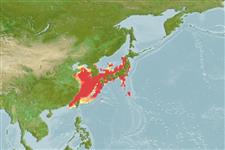Preferred temperature (Ref.
115969): 7.7 - 21.8, mean 17.4 (based on 199 cells).
Phylogenetic diversity index (Ref.
82804): PD
50 = 0.5156 [Uniqueness, from 0.5 = low to 2.0 = high].
Bayesian length-weight: a=0.00389 (0.00180 - 0.00842), b=3.12 (2.94 - 3.30), in cm Total Length, based on all LWR estimates for this body shape (Ref.
93245).
营养阶层 (Ref.
69278): 3.8 ±0.58 se; based on food items.
回复力 (Ref.
120179): 低的, 最小族群倍增时间4.5 - 14 年 (Fec=12).
Fishing Vulnerability (Ref.
59153): Very high vulnerability (82 of 100).
